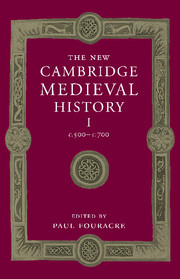Book contents
- Frontmatter
- Introduction: the history of Europe 500–700
- 1 The later Roman Empire
- 2 The Barbarian invasions
- 3 The sources and their interpretation
- PART I THE SIXTH CENTURY
- 4 The Eastern Empire in the sixth century
- 5 The Byzantines in the West in the sixth century
- 6 Ostrogothic Italy and the Lombard invasions
- 7 The formation of the Sueve and Visigothic kingdoms in Spain
- 8 Merovingian Gaul and the Frankish conquests
- 9 The Celtic kingdoms
- 10 The earliest Anglo-Saxon kingdoms
- PART II THE SEVENTH CENTURY
- PART III THEMES AND PROBLEMS
- List of Primary sources
- Bibliography of secondary works arranged by chapter
- Index
- Frontispiece"
- Plate section"
- Map 3 Gaul/Francia in the sixth and seventh centuries"
- References
8 - Merovingian Gaul and the Frankish conquests
from PART I - THE SIXTH CENTURY
Published online by Cambridge University Press: 28 March 2008
- Frontmatter
- Introduction: the history of Europe 500–700
- 1 The later Roman Empire
- 2 The Barbarian invasions
- 3 The sources and their interpretation
- PART I THE SIXTH CENTURY
- 4 The Eastern Empire in the sixth century
- 5 The Byzantines in the West in the sixth century
- 6 Ostrogothic Italy and the Lombard invasions
- 7 The formation of the Sueve and Visigothic kingdoms in Spain
- 8 Merovingian Gaul and the Frankish conquests
- 9 The Celtic kingdoms
- 10 The earliest Anglo-Saxon kingdoms
- PART II THE SEVENTH CENTURY
- PART III THEMES AND PROBLEMS
- List of Primary sources
- Bibliography of secondary works arranged by chapter
- Index
- Frontispiece"
- Plate section"
- Map 3 Gaul/Francia in the sixth and seventh centuries"
- References
Summary
The later Roman Empire provided little indication that the future of early medieval Europe lay with the Franks. From the later third century, Germans whom the literary sources called Franks had joined with other barbarians to challenge Roman rule in Gaul. These Franks included various peoples that had previously settled north and east of the lower Rhine. Although hostilities continued, by the beginning of the fourth century some Franks had been resettled throughout northern Gaul inside the Roman Empire. In particular, by the middle of the century the Salian Franks had settled in Toxandria, a region south of the mouths of the Rhine. In return, the Franks provided recruits, and sometimes entire units, that served in the Roman army throughout the Mediterranean world. Franks also began to serve as officers, and like other Germans some rose to become important generals who influenced imperial politics. The Frank Bonitus, for instance, had supported the emperor Constantine during the civil wars at the beginning of the fourth century, while his son Silvanus learned ‘Roman culture’, accepted Christianity, and served as a general in Gaul. After being falsely slandered at the court of the emperor Constantius in 355, Silvanus even established himself briefly as a usurping emperor at Cologne – the only Frankish emperor before Charlemagne. The Frank Ricimer became commander-in-chief in the East, and was also a friend of leading aristocrats throughout the Empire; as commander-in-chief in the Western Empire his nephew Arbogast continued to campaign against his fellow Franks along the northern frontier and led the last successful Roman expedition across the Rhine.
Keywords
- Type
- Chapter
- Information
- The New Cambridge Medieval History , pp. 193 - 231Publisher: Cambridge University PressPrint publication year: 2005
References
- 9
- Cited by



